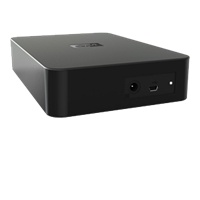How to install Debian on the NSLU2
Before we proceed with the installation of debian on the slug there is one point we bring in order:
We need a hard drive to install debian on.
My two slugs are installed in two different configurations:
Slug 1 (my home slug): A "WD Elements Desktop WDBAAU0010HBK 1 TB" (image) [Link 1, Link 2]
Slug 2 (my remote slug): A 4GB USB flash drive holding the operating system and a 300GB Maxtor hard drive to hold the data.
I recommend to install the OS on a single exteramnal harddrive. And make sure you choose one which is silent and energy efficient. I can recommend the above (WD Elements Desktop WDBAAU0010HBK 1 TB), which has served me faithfully 24 hours a day, 7 days a week for a year now, but any other will do just fine.
Second thing which is important to do:
- Connect the slug to power and your home switch and turn it on.
- Set up the IP of the slug, the subnet mask and default gateway and the DNS server, in the native (the one the NSLU2 comes with) interface such that it is accessible from the local network and such that it has internet access. The reason for this is that the debian installation will inherit the network settings from the native setup and will use these during the setup.
- Download and install Putty if you are running from Windows. If running from linux, just the use the built-in ssh which is sufficient.
- A screendump of Putty connecting to the default IP address 192.168.1.77 is attached. The username is blanked out for security reasons.
- Find and download the Debian install firmware. Doublecheck 3 times that you have the right firmware. You will find the latest Debian firmware here (on the 25th of Oct. 2010). Here I have linked to the unofficial image, which is the one I highly recommend. It is also the one I used for both of my slugs.
- There is a great guide on how to install Debian on NSLU2 here on cyrius' page. It is the guide/page that I used myself. It is also the one containing the link to the Debian firmware.
- Flash the slug with the downloaded firmware through the native Linksys NSLU2 interface.
- Turn off the slug
- Connect the harddrive.
- Turn on/reboot the slug.
- In Windows Connect to the slug through Putty (don't use other ways of connecting such as Cygwin, they will fail during the process). Or in Linux run the command below. In any case the username is "installer" and password is "install".
ssh installer@192.168.1.77
- Continue as described in Cyrius' guide.
- Choose to install to entire hard drive.
- Just use the Next, Next, Next approach whenever presented with a choice.
- While the installer is downloading and installing the packages it
would be a good time for you to think about what name your server
should have. In case you want to make it available online and are
sitting behind a dynamic public IP address, it would be a good time to
check whether this name is available at dynamic DNS services such as dyndns.com. The thing is, that there
exists a dns-updater for Debian which I use, recommend and will
introduce later. Therefore I recommend dyndns.com.
Therefore: If you want to make the server available online, go to dyndns.com, find a available hostname which suits you (but choose with care as you might get unwanted visitors if you choose a domain name which is too common - Use your common sense!).
Create an account (might as well be with the same username as you intend to use as domain name), "buy" the domain name (for 0.00$), active it etc. - Let the installer finish.
- As any guide online will tell you: "it is recommended that you install the ntpdate (or ntp) package to make sure the clock is always up-to-date. "
sudo apt-get update; sudo apt-get install ntpdateor
sudo apt-get update; sudo apt-get install ntp
- There, we have installed a full Debian server on your slug. You now have a full server consuming 2W+whatever your hard drive consumes. In the next few articles I will describe how to install and configure services you might need/want.

